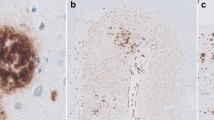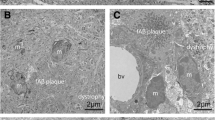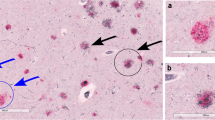Abstract
Ultrastructural three-dimensional reconstruction of human classical plaques in different stages of development shows that microglial cells are the major factor driving plaque formation by fibrillar amyloid-β (Aβ) deposition. The amount of fibrillar Aβ released by microglial cells and the area of direct contact between amyloid and neuron determine the extent of dystrophic changes in neuronal processes and synapses. The volume of hypertrophic astrocytic processes separating fibrillar amyloid from neuron is a measure of the protective activation of astrocytes. On the bases of the volume of amyloid star, microglial cells, dystrophic neurites, and hypertrophic astrocytic processes, and spatial relationships between plaque components, three stages in classical plaque development have been distinguished: early, mature, and late. In early plaque, the leading pathology is fibrillar Aβ deposition by microglial cells with amyloid star formation. The mature plaque is characterized by a balance between amyloid production, neuronal dystrophy, and astrocyte hypertrophy. In late classical plaque, microglial cells retract and expose neuropil on direct contact with amyloid star, enhancing both dystrophic changes in neurons and hypertrophic changes in astrocytes. In late plaques, activation of astrocytes predominates. They degrade amyloid star and peripheral amyloid wisps. The effect of these changes is classical plaque degradation to fibrillar primitive and finally to nonfibrillar, diffuse-like plaques.
Similar content being viewed by others
Author information
Authors and Affiliations
Additional information
Received: 27 October 1999 / Revised: 17 December 1999 / Accepted: 28 December 1999
Rights and permissions
About this article
Cite this article
Wegiel, J., Wang, KC., Tarnawski, M. et al. Microglial cells are the driving force in fibrillar plaque formation, whereas astrocytes are a leading factor in plaque degradation. Acta Neuropathol 100, 356–364 (2000). https://doi.org/10.1007/s004010000199
Issue Date:
DOI: https://doi.org/10.1007/s004010000199




